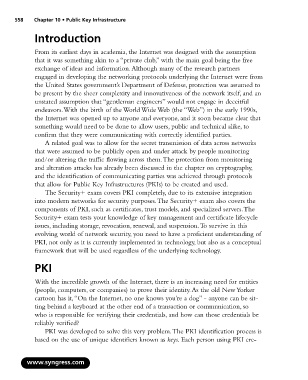Page 574 - StudyBook.pdf
P. 574
558 Chapter 10 • Public Key Infrastructure
Introduction
From its earliest days in academia, the Internet was designed with the assumption
that it was something akin to a “private club,” with the main goal being the free
exchange of ideas and information.Although many of the research partners
engaged in developing the networking protocols underlying the Internet were from
the United States government’s Department of Defense, protection was assumed to
be present by the sheer complexity and innovativeness of the network itself, and an
unstated assumption that “gentleman engineers” would not engage in deceitful
endeavors.With the birth of the World Wide Web (the “Web”) in the early 1990s,
the Internet was opened up to anyone and everyone, and it soon became clear that
something would need to be done to allow users, public and technical alike, to
confirm that they were communicating with correctly identified parties.
A related goal was to allow for the secret transmission of data across networks
that were assumed to be publicly open and under attack by people monitoring
and/or altering the traffic flowing across them.The protection from monitoring
and alteration attacks has already been discussed in the chapter on cryptography,
and the identification of communicating parties was achieved through protocols
that allow for Public Key Infrastructures (PKIs) to be created and used.
The Security+ exam covers PKI completely, due to its extensive integration
into modern networks for security purposes.The Security+ exam also covers the
components of PKI, such as certificates, trust models, and specialized servers.The
Security+ exam tests your knowledge of key management and certificate lifecycle
issues, including storage, revocation, renewal, and suspension.To survive in this
evolving world of network security, you need to have a proficient understanding of
PKI, not only as it is currently implemented in technology, but also as a conceptual
framework that will be used regardless of the underlying technology.
PKI
With the incredible growth of the Internet, there is an increasing need for entities
(people, computers, or companies) to prove their identity.As the old New Yorker
cartoon has it,“On the Internet, no one knows you’re a dog” - anyone can be sit-
ting behind a keyboard at the other end of a transaction or communication, so
who is responsible for verifying their credentials, and how can those credentials be
reliably verified?
PKI was developed to solve this very problem.The PKI identification process is
based on the use of unique identifiers known as keys. Each person using PKI cre-
www.syngress.com

